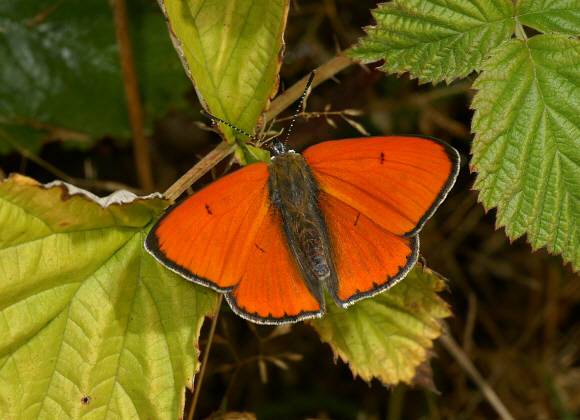 Large Copper Lycaena dispar batavus, male – Adrian Hoskins
Large Copper Lycaena dispar batavus, male – Adrian Hoskins
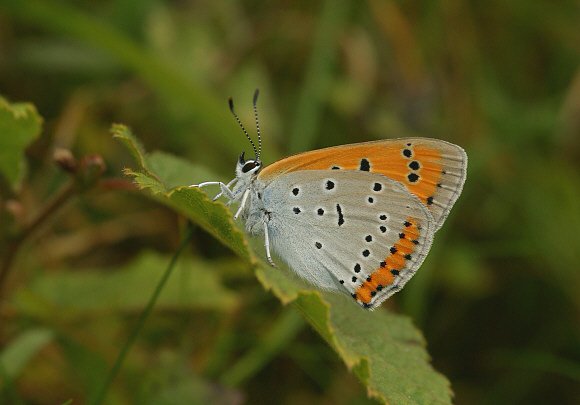 Large Copper Lycaena dispar batavus, female – Adrian Hoskins
Large Copper Lycaena dispar batavus, female – Adrian Hoskins
Introduction
The Large Copper is one of Europe’s most beautiful butterflies, the dazzling iridescent copper wings of the male equalling in brilliance any species found in the tropics. The female is equally stunning, with a pattern similar to that of the Small Copper, but having almost double it’s wingspan.
The butterfly was first discovered in 1749 at Dozens Bank in Lincolnshire, and was originally given the name “Orange Argus of Elloe”. The English subspecies Lycaena dispar dispar was always considered to be a rare and localised insect, found only in the Norfolk Broads and on the fens of Cambridgeshire and Huntingdonshire. Unfortunately for the Large Copper, most of these habitats, including it’s most famous site Whittlesea Mere, were drained for agriculture – a process that began in the early 17th century. By the beginning of the 19th century almost all of its breeding sites had been converted to farmland, and the butterfly was on the verge of extinction. The last known specimens were captured at Bottisham, Cambridgeshire in 1851.
The butterfly, in the form of subspecies rutilus, continued to thrive in parts of Europe however, and is still found in France, Italy, Germany, Latvia, Poland, southern Finland, Greece and eastern Turkey. This subspecies was artificially introduced to a bog in Tipperary, Ireland in 1913, where it survived for 43 years until the site became overgrown.
In 1915 another race of the butterfly was discovered in the Netherlands, and given the name Lycaena dispar batavus. It very closely resembles the original English race, and was introduced to Woodwalton Fen, a tiny fragment of fen surrounded by hundreds of square miles of intensive agriculture, in 1927.
Woodwalton Fen had been specially prepared to receive the Large Copper, and had been planted with substantial amounts of the larval foodplant Rumex hydrolapathum. At first the project was seen as a major success, with over a thousand adults recorded there in 1928. Unfortunately the site proved very difficult and costly to manage, and the species survived there only with considerable assistance from the wardens, who bred the butterflies in a greenhouse and released batches of adults every year to boost the failing wild population. It finally became extinct there in the early 1990’s, but may be reintroduced there or elsewhere in Britain at some stage in the future.
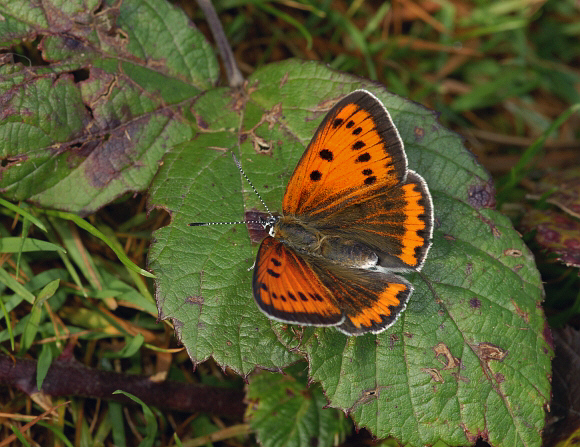 Large Copper Lycaena dispar batavus, female – Adrian Hoskins
Large Copper Lycaena dispar batavus, female – Adrian Hoskins
Habitats
This species breeds only on wet fenlands and around the boggy margins of lakes, rivers and canals where the larval foodplant Rumex hydrolapathum grows in profusion. Suitable habitats no longer exist in Britain, but the Great Fen Project, which aims to restore large areas of fenland in eastern England, may eventually recreate an environment which would justify a further reintroduction.
In the Netherlands batavus is found only at Weerribben and Wieden in Overijjsel, where it breeds around the margins of lakes formed by peat cutting.
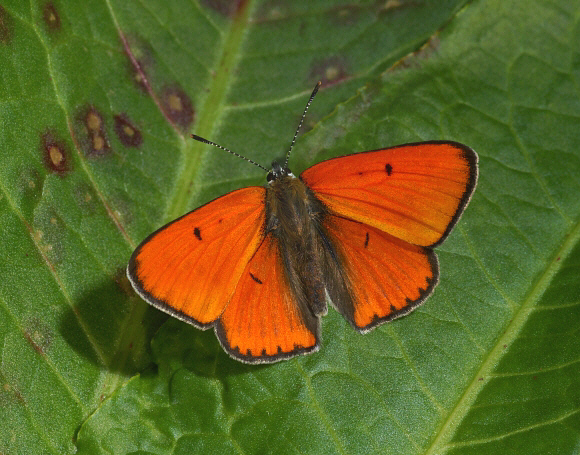 Large Copper Lycaena dispar batavus, male – Adrian Hoskins
Large Copper Lycaena dispar batavus, male – Adrian Hoskins
Lifecycle
In Britain and the Netherlands the butterfly is single-brooded, emerging in late July and early August, but in warmer parts of the species range it is double-brooded, emerging in late May and late August.
The heavily sculpted eggs are laid singly on leaves of the foodplant, although sometimes a leaf may be visited several times by one or more females, resulting in clusters of 3 or 4 eggs, laid in proximity to the midrib or other prominent ribs. Females usually avoid ovipositing on plants growing at the water’s edge, choosing instead those that grow in warm sheltered situations among regenerating vegetation. In Britain and the Netherlands they are always laid on great water dock R. hydrolapathum but the subspecies rutilus ( found elsewhere in Europe ) additionally uses R. crispus and R. aquaticus.
The young caterpillars feed on the underside of the leaves, nibbling out little grooves but leaving the upper cuticle of the leaf intact. Larvae of batavus ( and those of the 2nd brood of rutilus ) hibernate when quite small, attaching themselves to a silken pad spun on the underside of a dead leaf. They can withstand being submerged for as long as 3 months during the winter. In the spring they resume feeding, leaving a distinctive lattice of irregular shaped holes in the leaf. The fully grown caterpillar is bright emerald green, smooth in texture, and shaped like a woodlouse.
The chrysalis is plump, rounded, and buff in colour, with dull greyish markings along the sides of the abdomen. It is attached by a silk girdle to a stem of the foodplant.
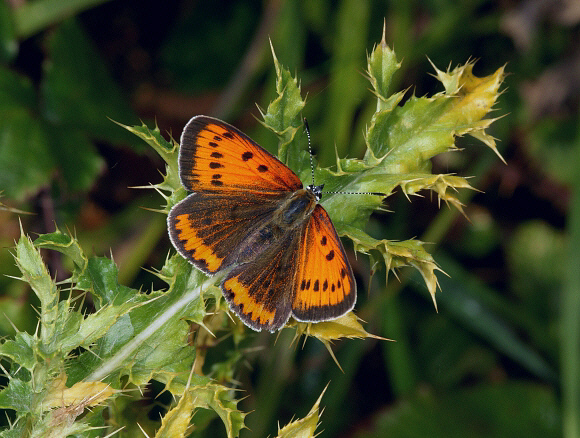 Large Copper Lycaena dispar batavus, female – Adrian Hoskins
Large Copper Lycaena dispar batavus, female – Adrian Hoskins
Adult behaviour
Males have a rapid jinking flight just above the herbage, and periodically settle to bask on thistle or dock leaves. They spend long periods nectaring at marsh thistles and use them as territorial lookout posts from which they dart off to investigate passing insects. Females are much more sedentary in behaviour, spending long periods basking on low vegetation. I have not observed the courtship but Thomas states that the pre-nuptial flight is brief, consisting of the male “flapping his wings over the hen” prior to copulation.
